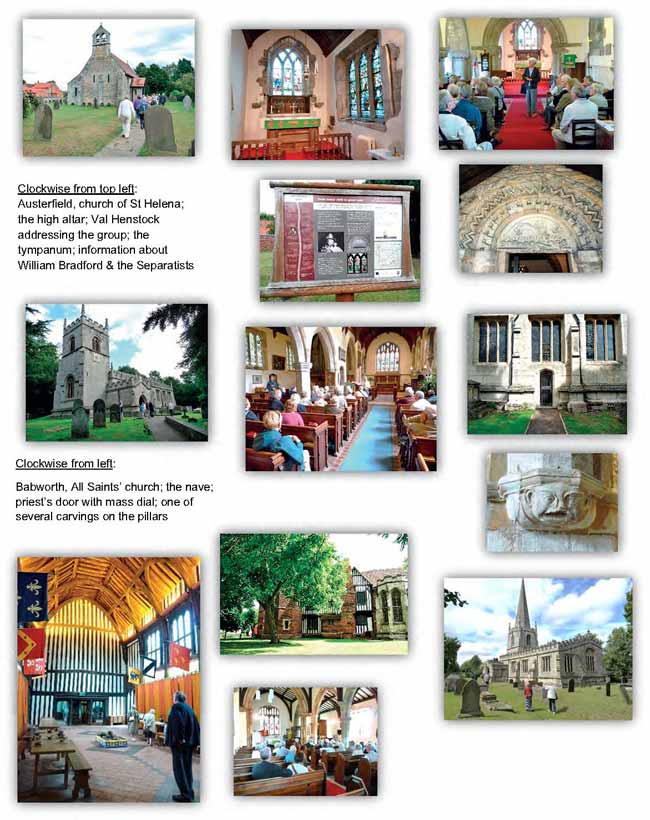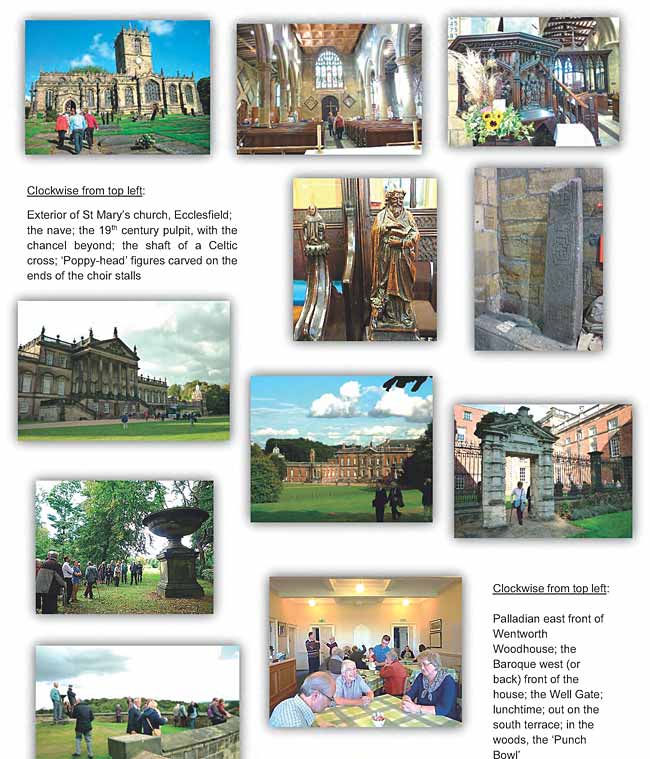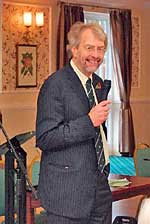Events and excursions, Autumn 2015
The Pilgrim Father's Trail
4th August 2015 Leaders: Valerie Henstock with Derek and Ceril Little
Some 42 members of the Thoroton Society travelled along this Trail, set in a landscape that is still largely rural and agricultural. Our first stop was at Babworth, where we were given a warm welcome, with coffee and biscuits. The Church Warden, an old pupil of the late Keith Train, a much respected former member of the Society, gave us an excellent outline, not only of Babwortrf s part in the Mayflower enterprise, but of the many parishes in this part of North Nottinghamshire which also were involved. He reminded us of the powerful influence at this time of the Established Church over the private and personal lives of the populace. The dismissal of the Rector of Babworth in 1605 for preaching Separatism (separation from the Church of England) ultimately led to the departure for North America of the Pilgrim Fathers. Thus North Nottinghamshire played a not inconsiderable part in the founding of the United States of America.
After lunch in Retford, we then travelled to Austerfield, just over the county boundary in South Yorks. The beautiful little church of St. Helena is a gem of early medieval architecture and sculpture. Its part in the story of the Pilgrim Fathers is that the future Governor of the colony of New Plymouth, William Bradford, was born in Austerfield and baptised in the church.
Our next visit was to Scrooby, birthplace of William Brewster, who together with William Bradford founded New Plymouth colony. The nearby village hall contains an interesting display about the Pilgrim Fathers. A notable exhibit is a large photograph recording the visit to Scrooby of Kingman Brewster, a descendant of William Brewster, who was US Ambassador to Britain in the 1960s.
Our final destination was Gainsborough Old Hall, home of the wealthy Hickman family who helped finance the voyage across the Atlantic of the Pilgrim Fathers.
Special thanks are due to Valerie Henstock, our excellent Guide and Tour Leader. In the course of our travels she gave us an in-depth account and explanation of the circumstances leading to the Pilgrim Fathers' epic.
Derek Little

St. Mary's church, Ecclesfield and Wentworth Woodhouse
22nd September 2015 Leader: Alan Langton
A pleasant run up the M1 in autumn sunshine took us to the (once) village of Ecclesfield, where road works caused a delay in our arrival at the twelfth century church of Saint Mary, once known as the 'Minster of the Moors'. A warm welcome with coffee and home-made cake was followed by a short talk and time to wander around the church and grounds where the priory house still stands. Of special interest is the very old rood screen and misericords, and the fine 'poppy-head' carvings on the bench ends in the Choir, reminiscent of those seen at Rotherham Minster on a previous excursion. Other special items include the shaft of a Celtic cross, some pieces of medieval glass in the north aisle, an original box pew, an old font thrown out into the vicarage garden in 1825 and subsequently restored, and the pulpit carved with scenes from the life of Saint Paul. In the churchyard is the tomb of Alexander Scott, chaplain to Horatio Nelson, and the graves of the Gatty family and their pets. The Rev Dr Alfred Gatty was Rector of Ecclesfield from 1839 to 1903, an incredible 64 years. His wife, Margaret Gatty, was a well-known author of children's books in the late Victorian era and a memorial tablet to her was erected by subscription from 'more than 1,000' children who had loved her work. Mrs Gatty is also known for her interest in sundials. Her 'Book of Sundials' was published in 1872. In 1862 Mrs Gatty donated a sundial to the churchyard of St Mary's. The dial was fixed on an old stone pillar which is thought formerly to have had a cross which had been destroyed by the Puritans. Sadly, the bronze dial was stolen some years ago.
Our short journey to Wentworth Woodhouse was lengthened by trying to find the drive wide enough to take the coach. The drive through the park up to the main entrance was beautiful, and the view of the longest facade of any other English country house was memorable. On our arrival, we enjoyed soup and sandwiches and tea before commencing the tour. Our excellent guides revealed not only much knowledge about the history of the House, but also a love of their interesting memories of it during its rather chequered more recent history. It is claimed to have 365 rooms; fortunately our tour covered only twenty three. The House was built originally in 1630 by the first Marquis of Rockingham, and then added to in both Palladian and decorated Baroque styles by later members of the family. Although many of the original furnishings are no longer there, it is possible to feel the grandeur and magnificence of the mansion in its heyday, when entertaining even the king and queen in 1912 was part of its 'normal' life. A tour of the grounds followed the inside tour, and before we journeyed home we enjoyed another cup of tea. The property is currently up for sale for £8 million.
[It was reported in The Times on Saturday 7th November that the house has, indeed, been sold for £8 million.]

Alan Langton
Annual luncheon 2015

Professor John Beckett welcoming members to the AGM.
Basford Hall, conference centre and miners' welfare venue, hosted our lunch this year on 7th November and sixty three members and friends were served a very enjoyable three-course meal. As usual we were welcomed by our Chair, Professor John Beckett, and Alan Langton led our grace. After lunch we raised our glasses for the toasts, John Beckett proposing that to the Queen and Trevor Lewis most eloquently the toast to the Society. Trevor reminded us of the excellent and varied programme and publications provided for members and thanked those who were responsible for providing them and for the support received on members' heritage concerns.
President Adrian Henstock responded to the toast with his thanks. He drew attention to this being a rare venture into territory to the north-western parts of the City of Nottingham; he thought that maybe this was because the area is not one noted for its picturesque villages and historic buildings. However, as he pointed out, the area is rich is history, especially over the last three hundred years; he reminded us that this area of the Leen Valley - Linby through Bulwell and Basford and down to Radford - could be considered the "engine house" of Nottingham's industry in the Georgian and Victorian periods, with important and growing industrial works including quarries producing Bulwell stone, cotton spinning mills, bleach works, malthouses and breweries. A powerhouse indeed and it was surely because of the importance of the parishes of Bulwell, Basford and Radford that they were the first to be annexed by Nottingham, despite their distance from its centre.
Adrian then turned to this building, Basford Hall, which has long been associated with the mining industry. Then to the most controversial part of the afternoon! - when was Basford Hall built? - 1740? 1769? Or, as Adrian stated, 1796? It was built by industrialist and experimental chemist Robert Hall, a respected and good employer who, the story goes, during the Luddite frame-breaking, received a letter from "Ned Lud" assuring him that his works would be safe. A later occupant was Thomas North, mining entrepreneur who later became Mayor.
Adrian concluded his response by saying that the Thoroton Society should be proud of its record of promoting, nurturing and publishing much of the research into industrial activity, and continuing to do so.
Barbara Cast, Honorary Secretary